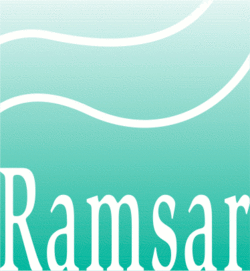Ramsar Convention
| Convention on Wetlands of International Importance, especially as Waterfowl Habitat | |
|---|---|
|
Ramsar logo | |
| Signed | February 2, 1971 |
| Location | Ramsar (Iran) |
| Effective | December 21, 1975 |
| Condition | Ratification by 7 states |
| Parties | 168 |
| Depositary | Director General of UNESCO |
| Languages |
English, French, German and Russian www |
The Ramsar Convention (formally, the Convention on Wetlands of International Importance, especially as Waterfowl Habitat) is an international treaty for the conservation and sustainable utilization of wetlands,[1] recognizing the fundamental ecological functions of wetlands and their economic, cultural, scientific, and recreational value. It is named after the city of Ramsar in Iran, where the Convention was signed in 1971.
Convention
The convention was developed and adopted by participating nations at a meeting in Ramsar, Mazandaran, Iran, on February 2, 1971, hosted by the Iranian Department of Environment, and came into force on December 21, 1975.
The Ramsar List of Wetlands of International Importance now includes 2186 Sites (known as Ramsar Sites) covering over 200,000,000 ha (490,000,000 acres). The country with the highest number of Sites is the United Kingdom at 170 and the country with the greatest area of listed wetlands is Bolivia, with over 140,000 km2 (54,000 sq mi).[2] The Ramsar definition of wetlands is fairly wide, including "areas of marine water the depth of which at low tide does not exceed six meters" as well as fish ponds, rice paddies and salt pans.[3]
Presently there are 168 contracting parties, up from 21 initial signatory nations in 1971. The state parties meet every three years as the Conference of the Contracting Parties (COP), the first held in Cagliari, Italy in 1980. Amendments to the original convention have been agreed to in Paris (in 1982) and Regina (in 1987).[4]
There is a standing committee, a scientific review panel, and a secretariat. The headquarters is located in Gland, Switzerland, shared with the IUCN.
International Organization Partners
The Ramsar Convention works closely with five other organisations known as International Organization Partners (IOPs). These are Birdlife International, the International Union for Conservation of Nature (IUCN), the International Water Management Institute (IWMI), Wetlands International and WWF International. These support the work of the Convention by providing expert technical advice, helping implement field studies and providing financial support. The IOPs also participate regularly as observers in all meetings of the Conference of the Parties and as full members of the Scientific and Technical Review Panel. For example, at the 2008 Convention of Parties, IWMI scientists contributed directly to a number of resolutions including those relating to wetlands' links to human health, biofuels, poverty reduction, biogeographic regionalization and biodiversity in rice paddies.
See also
- Ramsar Classification System for Wetland Type
- List of Ramsar wetlands of international importance
- Ramsar Wetland Conservation Award
- Environmental agreements
- Globally Important Agricultural Systems (GIAHS)
- World Wetlands Day
- Agreement on the Conservation of African-Eurasian Migratory Waterbirds
References
- ↑ Ramsar official website, retrieved 2011-07-10
- ↑ Ramsar Contracting Parties, retrieved 2009-11-07
- ↑ Viney, Michael (2013). "We're a wet country". Irish Times. Retrieved February 9, 2013.
- ↑ Ramsar: A brief history, retrieved 2009-11-07
External links
| Wikimedia Commons has media related to Ramsar Convention. |
- The Ramsar Convention on Wetlands
- Ramsar Sites Information Service, web service by a non-profit organisation Wetlands International, providing access to Ramsar database
- United States National Ramsar Committee
- Peace Palace Library, bibliography on Water Resources and International Law.
- Ramsar sites (Wetlands)and Ramsar sites in Brazil - Instituto Socioambiental


